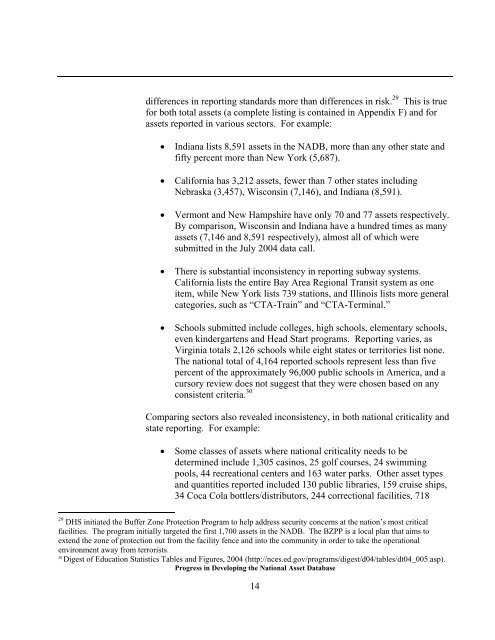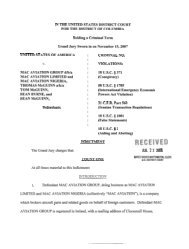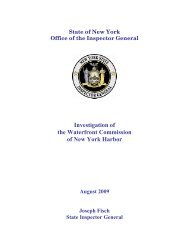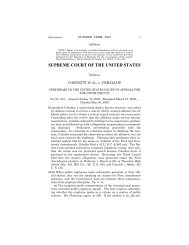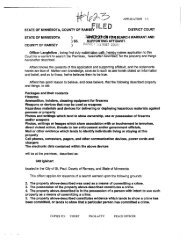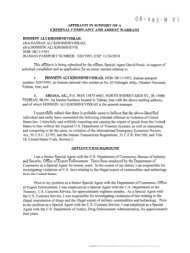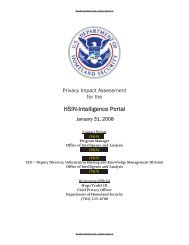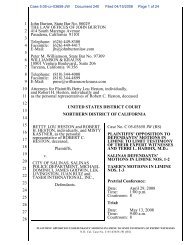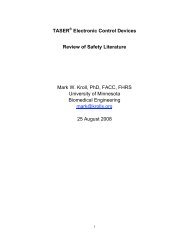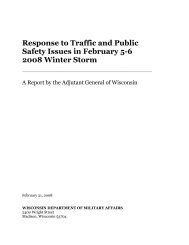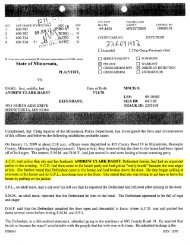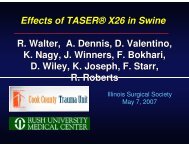Progress in Developing the National Asset Database
Progress in Developing the National Asset Database
Progress in Developing the National Asset Database
Create successful ePaper yourself
Turn your PDF publications into a flip-book with our unique Google optimized e-Paper software.
differences <strong>in</strong> report<strong>in</strong>g standards more than differences <strong>in</strong> risk. 29 This is truefor both total assets (a complete list<strong>in</strong>g is conta<strong>in</strong>ed <strong>in</strong> Appendix F) and forassets reported <strong>in</strong> various sectors. For example:• Indiana lists 8,591 assets <strong>in</strong> <strong>the</strong> NADB, more than any o<strong>the</strong>r state andfifty percent more than New York (5,687).• California has 3,212 assets, fewer than 7 o<strong>the</strong>r states <strong>in</strong>clud<strong>in</strong>gNebraska (3,457), Wiscons<strong>in</strong> (7,146), and Indiana (8,591).• Vermont and New Hampshire have only 70 and 77 assets respectively.By comparison, Wiscons<strong>in</strong> and Indiana have a hundred times as manyassets (7,146 and 8,591 respectively), almost all of which weresubmitted <strong>in</strong> <strong>the</strong> July 2004 data call.• There is substantial <strong>in</strong>consistency <strong>in</strong> report<strong>in</strong>g subway systems.California lists <strong>the</strong> entire Bay Area Regional Transit system as oneitem, while New York lists 739 stations, and Ill<strong>in</strong>ois lists more generalcategories, such as “CTA-Tra<strong>in</strong>” and “CTA-Term<strong>in</strong>al.”• Schools submitted <strong>in</strong>clude colleges, high schools, elementary schools,even k<strong>in</strong>dergartens and Head Start programs. Report<strong>in</strong>g varies, asVirg<strong>in</strong>ia totals 2,126 schools while eight states or territories list none.The national total of 4,164 reported schools represent less than fivepercent of <strong>the</strong> approximately 96,000 public schools <strong>in</strong> America, and acursory review does not suggest that <strong>the</strong>y were chosen based on anyconsistent criteria. 30Compar<strong>in</strong>g sectors also revealed <strong>in</strong>consistency, <strong>in</strong> both national criticality andstate report<strong>in</strong>g. For example:• Some classes of assets where national criticality needs to bedeterm<strong>in</strong>ed <strong>in</strong>clude 1,305 cas<strong>in</strong>os, 25 golf courses, 24 swimm<strong>in</strong>gpools, 44 recreational centers and 163 water parks. O<strong>the</strong>r asset typesand quantities reported <strong>in</strong>cluded 130 public libraries, 159 cruise ships,34 Coca Cola bottlers/distributors, 244 correctional facilities, 71829 DHS <strong>in</strong>itiated <strong>the</strong> Buffer Zone Protection Program to help address security concerns at <strong>the</strong> nation’s most criticalfacilities. The program <strong>in</strong>itially targeted <strong>the</strong> first 1,700 assets <strong>in</strong> <strong>the</strong> NADB. The BZPP is a local plan that aims toextend <strong>the</strong> zone of protection out from <strong>the</strong> facility fence and <strong>in</strong>to <strong>the</strong> community <strong>in</strong> order to take <strong>the</strong> operationalenvironment away from terrorists.30Digest of Education Statistics Tables and Figures, 2004 (http://nces.ed.gov/programs/digest/d04/tables/dt04_005.asp).<strong>Progress</strong> <strong>in</strong> Develop<strong>in</strong>g <strong>the</strong> <strong>National</strong> <strong>Asset</strong> <strong>Database</strong>14


